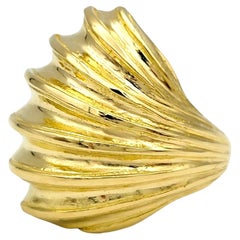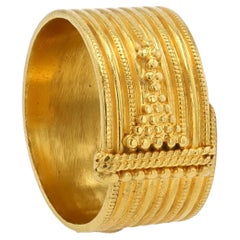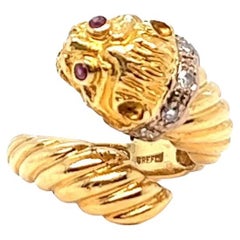Lalaounis Gold Wrap Ring
21st Century and Contemporary Unknown Contemporary Cocktail Rings
Gold, 22k Gold, Yellow Gold
Recent Sales
Vintage 1970s Greek Etruscan Revival Wedding Rings
Gold, 22k Gold
Vintage 1970s More Rings
Diamond, Ruby, 18k Gold, White Gold, Yellow Gold
Late 20th Century Greek Fashion Rings
18k Gold, Yellow Gold
20th Century Greek More Rings
18k Gold
20th Century Greek More Rings
Ruby, 18k Gold
People Also Browsed
Vintage 1970s American Artisan Band Rings
18k Gold
Late 20th Century Italian Cocktail Rings
Quartz, 18k Gold, Rose Gold
Vintage 1970s European Retro Cocktail Rings
Diamond, Turquoise, Platinum
20th Century American Modern Clip-on Earrings
18k Gold, Yellow Gold, Enamel
21st Century and Contemporary Italian Modern Link Bracelets
Diamond, Gold, 14k Gold, Yellow Gold
1990s American Modernist Fashion Rings
Turquoise, 14k Gold, Yellow Gold
Late 20th Century Italian Modernist Cocktail Rings
Malachite, Yellow Gold, 18k Gold, Gold
Vintage 1970s Italian Dome Rings
Jasper, Diamond, 18k Gold, Yellow Gold
21st Century and Contemporary Indian Contemporary Clip-on Earrings
Diamond, 18k Gold, White Gold
20th Century North American Solitaire Rings
Diamond, Platinum
2010s French Stud Earrings
Carnelian, Gold, 18k Gold, Rose Gold
1990s Italian Modern Pendant Necklaces
Diamond, White Diamond, Sapphire, 18k Gold, Yellow Gold
21st Century and Contemporary Italian Evening Bags and Minaudières
2010s Unknown Contemporary Cluster Rings
Diamond, White Diamond, Ruby, Platinum
Vintage 1980s American Modernist Choker Necklaces
Gold, 18k Gold, Yellow Gold
Vintage 1980s Pendant Necklaces
Gold, 18k Gold, Yellow Gold
Ilias Lalaounis for sale on 1stDibs
It’s fitting that Ilias Lalaounis (1920–2013) is the only jeweler ever inducted into the prestigious Académie des Beaux-Arts — the Greek jeweler’s creations, such as his decorative gold necklaces and rings, are less fashion adornment and more works of art.
Lalaounis was born in Athens in 1920 to a family of goldsmiths and watchmakers with origins in Delphi. Before turning to the family business, Lalaounis studied law, economics, business and music and trained with the painter Alexandros Alexandrakis. Such a well-rounded education laid the foundation for his unique approach to jewelry.
Lalaounis took the helm of his uncle’s jewelry company in 1940. The impact of the Second World War on Greece inspired the jeweler to celebrate his country’s history by reinterpreting its artifacts into new works of art. In 1957, Lalaounis founded the Greek Jewelers’ Association and exhibited at the Thessaloniki International Fair, showcasing the first of his “collections,” as he would come to define his phases of work. This, the Archaeological Collection, was informed by classical and Hellenistic history.
Lalaounis would go on to find new ways to render historic motifs in gold and gemstones after founding his namesake house in 1969. For his 1970s-era collection, Blow Up, he displayed gold pieces inspired by Minoan art on his models’ entire bodies; after opening a store in Tokyo, he presented a collection informed by Japanese art. Later, Lalaounis introduced a collection inspired by Native Americans at his Madison Avenue store in Manhattan. One of the jeweler’s most important commissions came in 1976, when he designed a collection that drew on Persian art for Empress Farah of Iran.
In 1984, Lalaounis explored his unique creative vision with a book, Metamorphoses. By the 1990s, he had stores across Europe as well as in Tokyo, Hong Kong and New York City, and his work had been exhibited at the National Museum of American History and the Penn Museum in Philadelphia, to name a few. In 1994, he founded his own eponymous museum in Athens, with a permanent collection of pieces from 45 of his collections. Lalaounis died in 2013.
Lalaounis’s research-driven approach to jewelry design gives his pieces a depth on par with any art form.
Find an ornate assortment of Ilias Lalaounis’s yellow-gold necklaces, rings and more on 1stDibs.
Why Gold Shines in Jewelry Craftsmanship
Gold is the feel-good metal, the serotonin of jewelry. Wear vintage and antique gold necklaces, watches, gold bracelets or gold rings and you feel happy, you feel dressed, you feel, well, yourself.
Gold, especially yellow gold, with its rich patina and ancient pedigree going back thousands of years, is the steady standby, the well-mannered metal of choice. Any discussion of this lustrous metal comes down to a basic truth: Gold is elementary, my dear. Gold jewelry that couples the mystique of the metal with superb design and craftsmanship achieves the status of an enduring classic. Many luxury houses have given us some of our most treasured and lasting examples of gold jewelry over the years.
Since its founding, in 1837, Tiffany & Co. has built its reputation on its company jewelry as well as its coterie of boutique designers, which has included Jean Schlumberger, Donald Claflin, Angela Cummings and Elsa Peretti. There are numerous gold Tiffany classics worth citing. Some are accented with gemstones, but all stand out for their design and the workmanship displayed.
For the woman who prefers a minimalist look, the Tiffany & Co. twist bangle (thin, slightly ovoid) is stylishly simple. For Cummings devotees, signature pieces feature hard stone inlay, such as her pairs of gold ear clips inlaid with black jade (a play on the classic Chanel black and tan), or bangles whose design recalls ocean waves, with undulating lines of lapis lazuli and mother-of-pearl. And just about any design by the great Jean Schlumberger is by definition a classic.
Even had he eschewed stones and diamonds, Southern-born David Webb would be hailed for the vast arsenal of heavy gold jewelry he designed. Gold, usually hammered or textured in some manner, defines great David Webb jewelry. The self-taught jeweler made very au courant pieces while drawing inspiration from ancient and out-of-the-way sources — East meets West in the commanding gold necklaces made by Webb in the early 1970s. The same could be said for his endlessly varied gold cuffs.
In Europe, many houses have given us gold jewelry that sets the highest standard for excellence, pieces that were highly sought after when they were made and continue to be so.
Numerous designs from Cartier are homages to gold. There are the classic Trinity rings, necklaces and bracelets — trifectas of yellow, white and rose gold. As a testament to the power of love, consider the endurance of the Cartier Love bracelet.
Aldo Cipullo, Cartier’s top in-house designer from the late 1960s into the early ’70s, made history in 1969 with the Love bracelet. Cipullo frequently said that the Love bracelet was born of a sleepless night contemplating a love affair gone wrong and his realization that “the only remnants he possessed of the romance were memories.” He distilled the urge to keep a loved one close into a slim 18-karat gold bangle.
BVLGARI and its coin jewelry, gemme nummarie, hit the jackpot when the line launched in the 1960s. The line has been perennially popular. BVLGARI coin jewelry features ancient Greek and Roman coins embedded in striking gold mounts, usually hung on thick link necklaces of varying lengths. In the 1970s, BVLGARI introduced the Tubogas line, most often made in yellow gold. The Tubogas watches are classics, and then there is the Serpenti, the house's outstanding snake-themed watches and bracelets.
A collection called Monete that incorporated the gold coins is one of several iconic BVLGARI lines that debuted in the 1970s and ’80s, catering to a new generation of empowered women. Just as designers like Halston and Yves Saint Laurent were popularizing fuss-free ready-to-wear fashion for women on the go, BVLGARI offered jewels to be lived in.
Since Van Cleef & Arpels opened its Place Vendôme doors in 1906, collection after collection of jewelry classics have enchanted the public. As predominantly expressed in a honeycomb of gold, there is the Ludo watch and accessories, circa the 1920s, and the golden Zip necklace, 1951, whose ingenious transformation of the traditional zipper was originally proposed by the Duchess of Windsor. Van Cleef's Alhambra, with its Moroccan motif, was introduced in 1968 and from the start its popularity pivoted on royalty and celebrity status. It remains one of VCA’s most popular and collected styles.
Mention must be made of Buccellati, whose name is synonymous with gold so finely spun that it suggests tapestry. The house’s many gold bracelets, typically embellished with a few or many diamonds, signified taste and distinction and are always in favor on the secondary market. Other important mid-20th-century houses known for their gold-themed jewelry include Hermès and Ilias Lalaounis.
Find a stunning collection of vintage and antique gold jewelry on 1stDibs.
Finding the Right Rings for You
Antique and vintage rings have long held a special place in the hearts of fine jewelry lovers all over the world.
No matter their origin or specific characteristics, rings are timeless, versatile accessories. They’ve carried deep meaning since at least the Middle Ages, when diamond rings symbolized strength and other kinds of rings were worn to signify romantic feelings or to denote an affiliation with a religious order. Rings have also forever been emblematic of eternity.
Over time, rings have frequently taken the form of serpents, which have long been associated with eternal life, health and renewal. Italian luxury jewelry house Bulgari has become famous for its widely loved Serpenti motif, for example, and its Serpenti ring, like the other accessories in the collection, began as an homage to jewelry of the Roman and Hellenistic eras. The serpent is now a popular motif in fine jewelry. Jewelry devotees have long pined for rings adorned with reptiles, thanks to antique Victorian rings — well, specifically, Queen Victoria’s illustrious engagement ring, which took the form of a gold snake set with rubies, diamonds and an emerald (her birthstone). Designs for Victorian-era engagement rings often featured repoussé work and chasing, in which patterns are hammered into the metal.
Engagement rings, which are reliably intimidating to shop for, are still widely recognized as symbols of love and commitment. On 1stDibs, a range of buying guides can be found for those in the market for antique engagement rings, vintage engagement rings or Art Deco engagement rings.
The most collectible antique engagement rings and vintage engagement rings are those from the Victorian, Edwardian and Art Deco eras. Named for the monarchies of the four King Georges, who in succession ruled England starting in 1714 (plus King William’s reign), antique Georgian rings, be they engagement rings or otherwise, are also coveted by collectors. Pearls, along with colored gemstones like garnets, rubies and sapphires, were widely used in Georgian jewelry. The late-1700s paste jewelry was a predecessor to what we now call fashion or costume jewelry.
The Art Nouveau movement (1880–1910) brought with it rings inspired by the natural world. Antique Art Nouveau rings might feature depictions of winged insects and fauna as well as women, who were simultaneously eroticized and romanticized, frequently with long flowing hair. Art Deco jewelry, on the other hand, which originated during the 1920s and ’30s, is by and large “white jewelry.” White metals, primarily platinum, were favored over yellow gold in the design of antique Art Deco rings and other accessories as well as geometric motifs, with women drawn to the era’s dazzling cocktail rings in particular.
Whether you’re hunting down a chunky classic for a Prohibition-themed cocktail party or seeking a clean contemporary design to complement your casual ensemble, find an exquisite collection of antique, new and vintage rings on 1stDibs.


